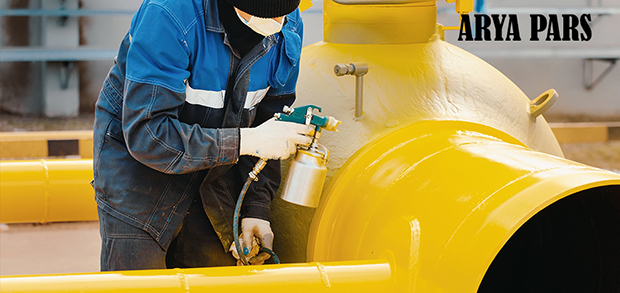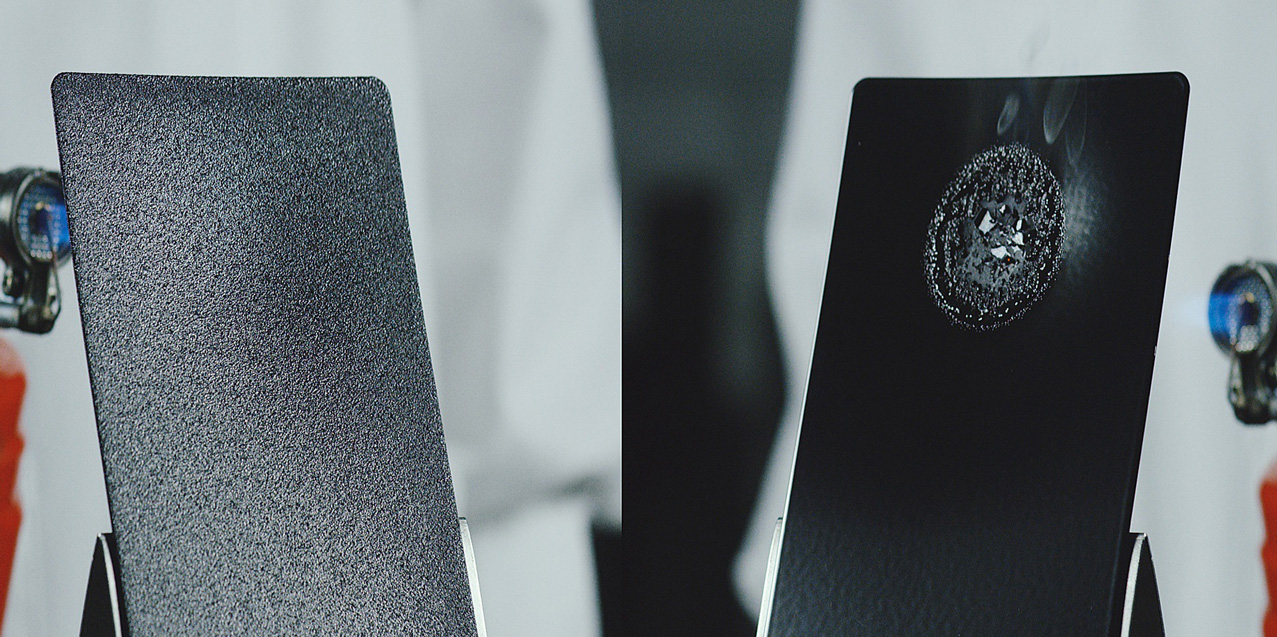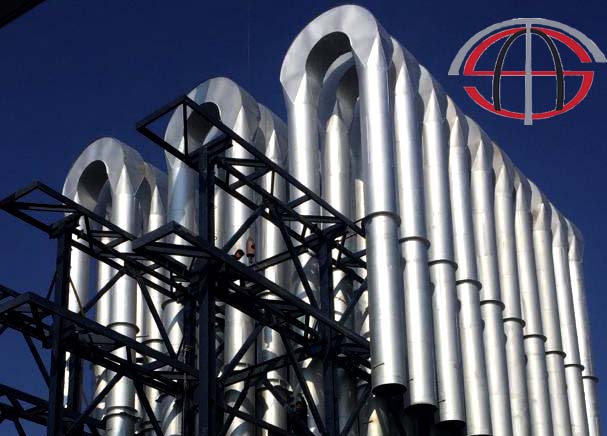Heat-resistant paints are one of the types of industrial coatings whose base is selected from silicone resin and aluminum pigment. The heat-resistant properties of silicone resin along with aluminum pigment have made this type of paint withstand temperatures up to 650 °C and above (about 750 °C). This coating is used due to its non-fading and maintaining properties at high temperatures.
What is heat-resistant paint and how does it work?
Heat-resistant paint is designed to withstand high temperatures. They are made in such a way that they will not deteriorate or decompose if exposed to extreme temperatures. Some of the paints in this group can withstand temperatures of up to 750 degrees Celsius and provide higher surface protection against heat. But there is no “best heat-resistant paint”. It all depends on the environment and the intended platform.
Heat-resistant paint is used to protect surfaces that are exposed to heat.
Heat-resistant paint properties
Among the properties of heat-resistant paints, the following can be mentioned:
– High adhesion on different types of surfaces
– High chemical resistance and no change at high temperatures
– Short drying time
– Beautiful appearance and silver color
– Protection against corrosion
Heat-resistant paint can be used in simple applications such as home fireplaces and even
industrial surfaces such as boilers, high temperature transmission pipes, furnaces, refineries, petrochemical plants, various oil industries, tanks under high temperatures, etc.
It should be noted that the application of heat-resistant paint in high thicknesses may cause the paint to sag, resulting in an inadequate and low-quality coating. Heat-resistant paint is typically applied in layers with a thickness of about 20 to 30µ, and for large surfaces with high area, the use of sprays and pistols is recommended. Due to the low thickness of the final dry film, this coating exhibits relatively low mechanical resistance.
Heat-resistant paint is suitable for use in engines, exhausts, BBQs, stoves, fireplaces, steam boilers, radiators, chimneys, and other areas exposed to high temperatures. If you are looking for heat-resistant paint or coating to provide the highest level of surface protection under extreme heat conditions, you will find it here.
Differences between Polyurethane Paints and Heat-resistant Paints
Polyurethane and epoxy paints are generally resistant up to temperatures of 100°C to 120°C, but heat-resistant paint is recommended for applications at higher temperatures. The application and execution of heat-resistant paint are straightforward and easy. The key to starting the work lies in proper surface preparation and substrate, ensuring the surface is clean, free from any contamination, and dust-free. Surface readiness and cleanliness ensure better adhesion of heat-resistant paint.
What do you know about heat-resistant paint?
First of all, you should know that high-temperature paint, fireproof spray paint, and heat-resistant spray paint are similar products. All these products provide a beautiful and durable protection for commercial and industrial surfaces exposed to constant heat ranging from 500°F to 1500°F. They are also very effective for protection against corrosion and moisture resistance in harsh indoor or offshore environments. Standard colors are often black and silver (also known as aluminum). However, you can also find other colors such as oxide gray, white, orange, or red.
Types of Heat-resistant Paint
There are four types of heat-resistant paint:
- Silicone or Epoxy-Based Multi-Polymer Paint: This type of paint is formulated to demonstrate resistance to high temperatures when used in new construction or maintenance coatings. It can also be used on a hot substrate without affecting the layer. Generally, higher silicon content results in higher heat resistance.
- High-Temperature Powder Coating: High-temperature powder coating is often silicone and epoxy-based (similar to high-temperature liquid paint). However, it performs better at temperatures above 4000°F to 10000°F. It is also VOC-free and has a wide range of gloss and complete color options.
- Metallic Additive Coatings and Metallic Spray Paints: They are used for corrosion protection along with heat resistance. Aluminum heat-resistant spray is used to prevent CUI (corrosion under insulation) on platforms and plants away from the shore and coastline. Meanwhile, metallic pigments are used as temperature stabilizers up to 7500°F.
- High-Temperature Ceramic Paint: This type is well-known for its heat resistance properties. It also provides chemical resistance, corrosion protection, and a hard final finish. When high-pressure ceramic paint is used, the insulation and underlying metal are well protected.
Industrial heat-resistant paints produced by Arya Paint Company are as follows
– Heat-resistant paint resistant up to 250°C
– Heat-resistant paint resistant up to 400°C
– Heat-resistant paint resistant up to 650°C
Depending on the application and the temperature in which the desired surface is located, and according to the working conditions and the weather environment, the appropriate heat-resistant paint is selected. It is suggested to use zinc steel silicate primer to prevent corrosion of metal surfaces and to make the surface more resistant to temperature and heat. In general, the main application of this type of paint is on surfaces that are in constant contact with heat and high temperature.
Which product should I choose?
Our heat-resistant paints come in paint, primer, or aerosol form and each gives you a choice during the application process. Our heat-resistant spray paints are extremely popular, providing an easy way to apply paint without the need for a brush or roller.
If you are not sure which heat-resistant coating to buy, contact the company’s technical department. We can discuss all possible options with you.
Extreme temperatures always stimulate oxidation, which leads to pitting, rusting, and even loss of structural support. That’s why the selection of a suitable coating using high-temperature paint is crucial to prevent such occurrences. High-temperature paint has properties that can contribute to savings in exhaust systems, industrial machinery, engine manifolds, outdoor furnaces, etc.
For this reason, many users tend to use these paints to improve the appearance and protect exterior surfaces. But do you know how to use it properly? Is there anything to consider? Are they suitable for all surfaces?
Industrial heat-resistant paint produced by Arya Sath Tehran
Common Applications for Heat-Resistant Paint
Arya Pars industrial heat-resistant paints are used across a wide range of industries. Spray heat-resistant paints are utilized for household purposes, painting car engines and gearboxes, steam pipes, diesel exhaust systems, engines, radiators, furnaces, wood stoves, braziers, barbecue ovens, stoves, waste incinerators, and more. Some household applications for heat-resistant paint are outlined below.
Painting a Gas Stove
Before starting the painting process, contact the manufacturer of your household appliances to ensure the suitability of the paint. There are three main stages involved in this process. For painting a gas stove, you should use heat-resistant spray paints designed for cast iron gas appliances (currently not listed in Arya Pars product list).
Prepare the Surface
In the first stage, you should inspect and eliminate any rust, peeling, or blistering on the surface of the gas stove. Sanding or sandblasting is a good method to assist you during this time. Afterward, do not forget to check for oil, dust, grease, or other contaminants, as these substances can prevent the paint from adhering to the gas stove. Then, use a degreaser to remove them. Next, prepare goggles, gloves, and anything else that can protect you from getting paint on yourself.
Apply the Paint
The first thing is to shake the can for about 1-2 minutes. This ensures that solvents and color pigments in the paint mix well. For the best results during spraying, make sure the surface temperature of the gas stove and the air is between 65 to 85 degrees Fahrenheit. It is okay to soak the paint can in warm water for 2 minutes to warm it up, but avoid excessive heating or exposure to open flames. Turn off the gas and all flames.
It is recommended to test the heat-resistant paint on a piece of cardboard to see if it is ready for use or not. Apply the first coat, wait for about 15 minutes, and then apply another layer. When painting, be sure to do this from a distance of 12-18 inches from the stove.
Types of Arya Pars Heat-resistant Paints:
- 250-Degree Heat-resistant Silicone-based Surface Paint
- 450-Degree Heat-resistant Silicone-based Surface Paint
- 600-Degree Heat-resistant Silicone-based Surface Paint
- 650-Degree Heat-resistant Silicone-based Surface Paint with 800-Degree Shock Tolerance
Before purchasing heat-resistant paint, consult with us.
Considering the relatively higher price of heat-resistant paint compared to other heat and mechanical resistant coatings, it is advisable to examine various aspects for precise and suitable coating selection or seek assistance from consultants. It is essential to note that domestically produced paints have a more reasonable price compared to their foreign counterparts and can be an economical and intelligent choice. Additionally, based on the application and method of applying heat-resistant paint, this coating responds suitably in various industries in the country.
Follow Arya Sath Tehran on social networks and browsers.
Other Products

1. Epoxy Paint

2. Polyurethane Paint







Leave a Reply